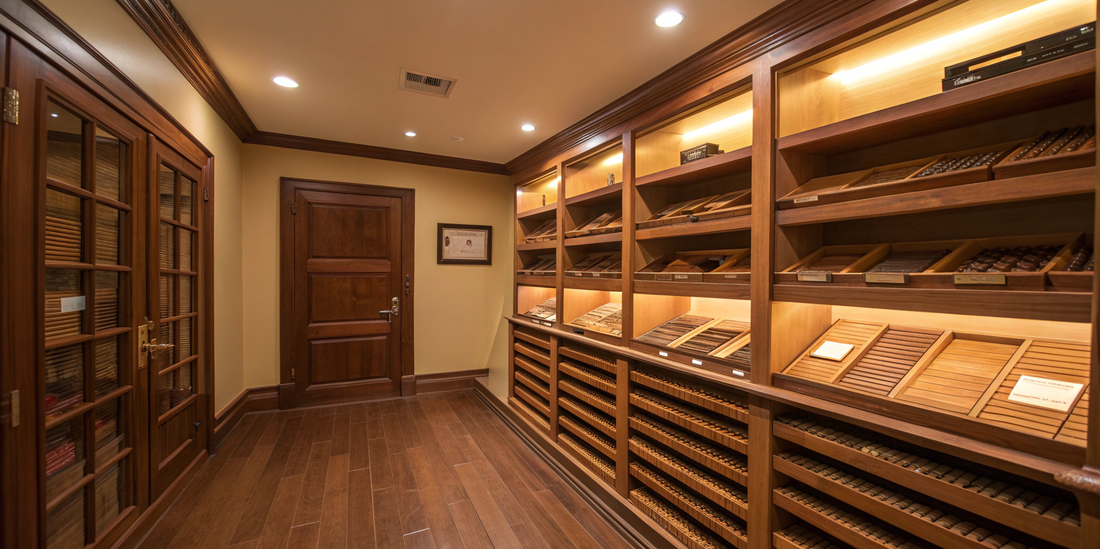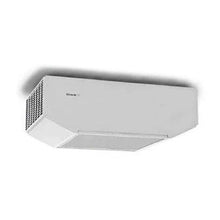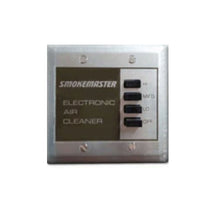Beyond the Humidor: The Science of Preserving Rare Cigars with Archival-Quality Air

By the Experts at Commercial Air Purifiers | Published: October 17, 2025
For the serious collector, a rare cigar is not merely a consumable luxury; it is an artifact. It represents a specific harvest, a moment in time, and the pinnacle of a master blender’s craft. Like a fine wine or a first-edition book, its value and character are meant to be nurtured, developing complexity over years, even decades. You have likely invested significant resources in the first two pillars of preservation: a high-quality humidor to maintain perfect temperature and humidity. But what about the third, invisible pillar? The quality of the very air that surrounds your collection is the final, crucial element in ensuring your prized cigars are truly protected for the long term.
This guide is for the collector who understands that preservation is a science. We will explore the hidden threats in your home’s ambient air—from invasive mold spores to flavor-altering chemicals—that can bypass even the best humidors. By applying the same principles used by museum archivists and conservation scientists, we will show you how advanced air purification can create a sanctuary for your collection, protecting your investment and ensuring that when the time finally comes, that 20-year-old cigar will be everything you hoped for.
The Silent Threats: Contaminants That Can Ruin a Collection
A well-made humidor is a masterpiece of environmental control, but it is not a hermetically sealed vault. By design, it must breathe to regulate humidity properly. This means the air within your humidor is in constant, slow exchange with the air in the surrounding room. Over time, any contaminants present in that room will inevitably find their way into your collection. For the long-term preservation of rare and delicate organic items like cigars, three primary airborne threats must be neutralized.
1. Mold and Fungi Spores: This is the most infamous enemy of the cigar collector. Spores from common household molds like Aspergillus and Penicillium are ubiquitous in virtually every indoor environment. As the U.S. Environmental Protection Agency (EPA) explains, mold spores are microscopic, float through the air, and can colonize any surface where conditions are right. While your humidor’s humidity is perfect for tobacco, it’s also an inviting environment for these spores. An infiltration can lead to a bloom of "cigar mold" (as opposed to the desirable crystalline "plume"), which can ruin the flavor and structural integrity of a cigar, rendering it worthless.
2. Volatile Organic Compounds (VOCs): This is the insidious, flavor-destroying threat that few collectors consider. VOCs are gaseous chemicals emitted by thousands of common household products. That "new furniture smell"? It’s formaldehyde off-gassing from pressed wood. The scent of cleaning solutions, air fresheners, paints, and carpets? All are VOCs. Tobacco is highly porous and hygroscopic, meaning it readily absorbs moisture—and aromas—from the air. Over months and years, your cigars can slowly absorb these ambient chemical aromas, causing a permanent and disastrous alteration of their delicate, natural flavor profile. Imagine your rarest Fuente Opus X slowly acquiring the faint chemical taste of a scented candle or a new rug.
3. Dust and Particulate Matter: While less damaging than mold or VOCs, fine dust can also pose a problem. These particles can carry other contaminants and, over time, can accumulate on the wrappers of your cigars, potentially affecting their texture and clogging the pores of the delicate leaf.
Lessons from the Archives: Applying Museum Standards to Your Collection
To understand how to best protect your cigars, we must look to the experts who preserve the world's most priceless organic artifacts. Museum conservators and archivists have spent decades perfecting the science of stopping decay, and their principles are directly applicable to a valuable cigar collection.
Thinking Like a Conservator: The Principles of Preservation
The long-term preservation of any organic material—whether it's an ancient manuscript, a botanical specimen, or a hand-rolled cigar—depends on the strict control of three environmental factors: temperature, relative humidity, and air purity. You have already mastered the first two with your humidor. The final step is to control the air.
According to the Canadian Conservation Institute, a leading authority on preservation, airborne pollutants pose a significant risk to museum collections. They state that pollutants, including gaseous chemicals like VOCs and particulates like dust and mold, can "cause irreversible damage" through chemical reactions that lead to discoloration, weakening, and disintegration. Their recommendation for protecting sensitive artifacts is unequivocal: a combination of high-efficiency particulate filtration and chemical/gaseous filtration. In essence, a collector must begin to think of themselves as a private curator, and the room housing their collection as a personal archive that requires the same level of environmental purity.
Why Your Home's Air is a Hostile Environment
The average home is an active, dynamic chemical environment. Formaldehyde from engineered wood products, acetic acid from wood finishes, sulfur compounds from drywall, and ozone from electronics all contribute to a low-level chemical soup in the air. While harmless to us in low concentrations, these reactive gases are in a constant state of seeking equilibrium—and the rich, porous organic material of your cigars is a perfect place for them to settle and bond. A cigar is a delicate chemical balance of oils, resins, and organic compounds; introducing foreign chemicals, even at a microscopic level, disrupts this balance and irrevocatesly taints the product.
The Technology of Preservation: A Deep Dive into Archival Filtration
Creating an environment of archival-quality air is not about scented candles or simple dust filters. It requires engineering a "clean room" environment using specific, medical-grade filtration technologies designed to remove both microscopic biological threats and harmful gaseous chemicals.
Absolute Particulate Control with HEPA Filtration
The foundation of any preservation-grade air system is a True HEPA filter. In the context of cigar preservation, its most important job is to function as an impenetrable barrier against biological threats. A certified HEPA filter captures 99.97% of all airborne particles down to 0.3 microns. This size range includes all common mold spores, fungi, bacteria, and fine dust. By installing a HEPA filtration system in the room where your humidor is located, you are effectively sterilizing the air of these microscopic invaders, ensuring they never have the opportunity to infiltrate your humidor and colonize your collection. It is the ultimate preventative measure against the dreaded mold bloom.
Neutralizing Chemical Threats with Broad-Spectrum Adsorption
This is the technology that protects the very soul of your cigars: their flavor. To remove the threat of VOCs and other gaseous pollutants, you need a substantial filter made of activated carbon. As we've discussed in other contexts, activated carbon uses a process called adsorption to trap chemical molecules. For archival purposes, the goal is to create chemically inert air, free from any reactive compounds that could taint your cigars.
This requires a filter with a massive internal surface area, which is only possible with a deep bed of carbon weighing many pounds. This ensures "broad-spectrum" adsorption, meaning it can effectively capture the wide variety of different VOCs found in a typical home. By continuously cycling the room's air through this carbon filter, you are stripping out the flavor-altering pollutants, creating a pure air buffer around your humidor that protects your cigars from chemical contamination.
Designing Your Preservation Environment: From Room to Vault
With the right technology in hand, the final step is to implement it strategically to create the ideal preservation environment.
Practical Steps to Creating a Safe Haven for Your Collection
Location is Key: The first step is to choose the right room for your collection. Ideally, this should be a low-traffic area with a stable temperature, away from sources of high contamination like kitchens (cooking fumes), bathrooms (moisture and mold), or workshops (chemical fumes). A dedicated office, library, or den is often a perfect choice.
The Room-Level Approach: The most effective strategy is not to try and place a small purifier inside your humidor, but to purify the entire volume of air in the room that houses it. This creates a "clean room" envelope that acts as a buffer zone. Any air that eventually makes its way into your humidor has already been scrubbed of particulates, mold spores, and VOCs.
Calculating Airflow for Continuous Purity: The goal of an archival system is different from that of a smoke-eating system. You do not need rapid, high-volume air changes. Instead, you need constant, steady, and quiet filtration to maintain a perpetual state of purity. A good target for a preservation room is 4-6 Air Changes per Hour (ACH). This ensures the air is consistently being polished without creating drafts or excessive noise. A system running 24/7 on a low, quiet setting is the ideal state for long-term preservation.
Your Action Plan for Long-Term Cigar Preservation
Protecting your investment requires a deliberate, scientific approach. Follow these steps to elevate your storage from a simple humidor to a true preservation-grade archive.
-
Analyze Your Environment: Take stock of the room where your cigars are stored. Identify potential sources of pollution, such as new furniture, air fresheners, cleaning closets, or nearby sources of moisture.
-
Implement 24/7 Dual-Stage Purification: The core of your strategy is a high-performance air purifier that combines a large HEPA filter with a substantial, deep-bed activated carbon filter. This system should be rated for the size of your room and operated continuously.
-
Create a Clean Buffer Zone: By constantly filtering the air in the entire room, you create a pure environment around your humidor, ensuring any air exchange is with clean, inert air. For environments where purity is paramount, explore our line of HEPA & Carbon Air Purifiers, designed for removing microscopic and gaseous contaminants.
-
Redefine Your Humidor's Role: Allow your humidor to do what it does best: maintain perfect temperature and humidity. Let your room-level air purifier handle the critical task of ensuring air purity. To better understand the invisible chemical threats in your home, read our guide: The Threat of VOCs in Your Home.
The Final Step in Curation
Your collection of rare cigars represents a significant investment of time, passion, and resources. Protecting it requires you to think beyond the cedar box and embrace the third pillar of preservation: air quality. By understanding the invisible threats of mold spores and flavor-altering VOCs, you can take the final step in becoming a true curator of your collection. The implementation of an archival-quality air purification system is the ultimate assurance that your cigars will age gracefully, protected from the hostile elements of the outside world, ready to deliver a perfect experience when the moment arrives.
Protect your investment. Explore our purifiers for archival-quality air.
A Collector's Preservation FAQ
My walk-in humidor has its own air circulation system. Isn't that enough?
While essential, most circulation systems in walk-in humidors are designed to maintain consistent temperature and humidity levels throughout the space. They are generally not equipped with the medical-grade HEPA and heavy-duty carbon filters needed to remove sub-micron mold spores and gaseous VOCs being drawn in from the surrounding building. A dedicated air purifier for the room itself provides this crucial layer of filtration.
Can I use an ozone generator to sterilize the room and prevent mold?
We strongly advise against this. While ozone is a sterilizing agent, it is also a powerful and indiscriminate oxidant. It can chemically damage the delicate organic oils and compounds in cigar tobacco, permanently and negatively altering the flavor profile. This, combined with the significant health warnings issued by the EPA, makes it an unsuitable and risky choice for a valuable collection.
How often should I run the air purifier in my collection room?
For preservation applications, continuous 24/7 operation on a low and quiet setting is the professional standard. The goal is to maintain a constant state of air purity, preventing pollutant levels from ever building up. This is far more effective than intermittent filtration.
Will an air purifier affect the humidity in my room or my humidor?
A standard high-performance air purifier is not a dehumidifier or a humidifier. Its sole function is to filter particles and gases from the air that passes through it. It has no impact on the room's relative humidity and will not interfere with the carefully controlled environment inside your humidor.



